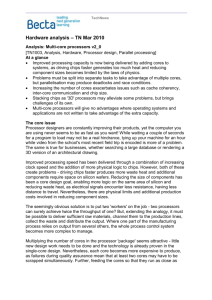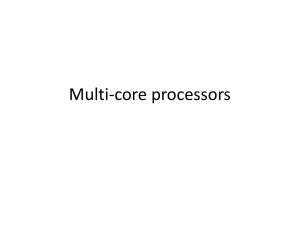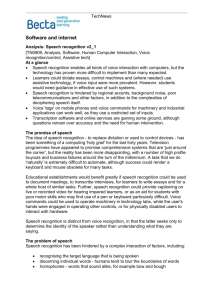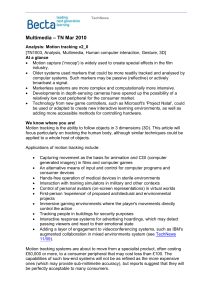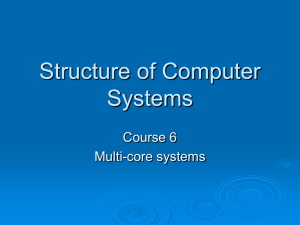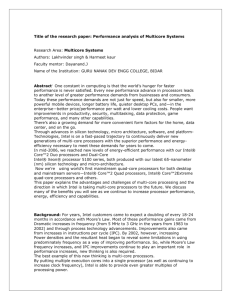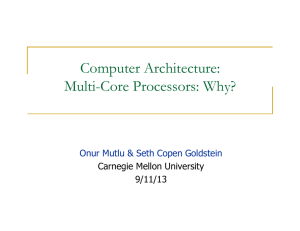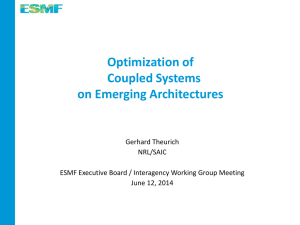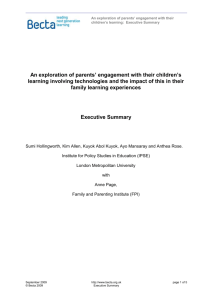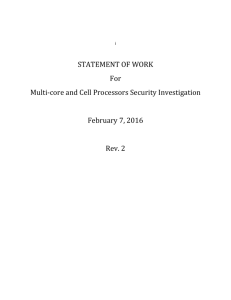SW Analysis: Parallel processing v2_0
advertisement
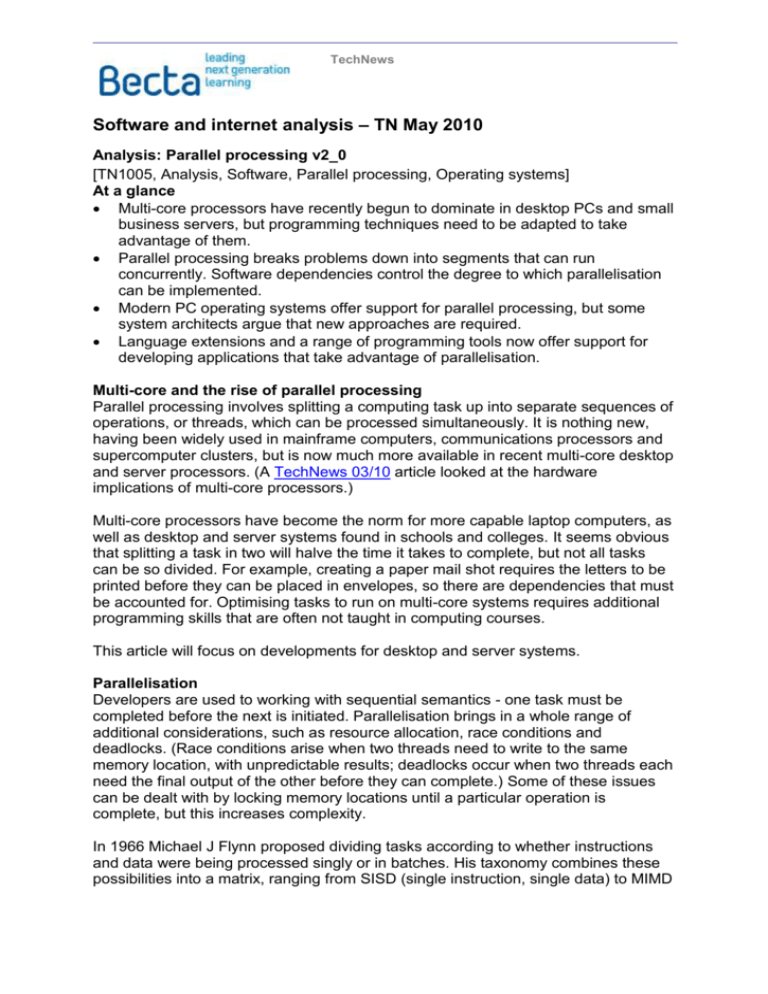
TechNews Software and internet analysis – TN May 2010 Analysis: Parallel processing v2_0 [TN1005, Analysis, Software, Parallel processing, Operating systems] At a glance Multi-core processors have recently begun to dominate in desktop PCs and small business servers, but programming techniques need to be adapted to take advantage of them. Parallel processing breaks problems down into segments that can run concurrently. Software dependencies control the degree to which parallelisation can be implemented. Modern PC operating systems offer support for parallel processing, but some system architects argue that new approaches are required. Language extensions and a range of programming tools now offer support for developing applications that take advantage of parallelisation. Multi-core and the rise of parallel processing Parallel processing involves splitting a computing task up into separate sequences of operations, or threads, which can be processed simultaneously. It is nothing new, having been widely used in mainframe computers, communications processors and supercomputer clusters, but is now much more available in recent multi-core desktop and server processors. (A TechNews 03/10 article looked at the hardware implications of multi-core processors.) Multi-core processors have become the norm for more capable laptop computers, as well as desktop and server systems found in schools and colleges. It seems obvious that splitting a task in two will halve the time it takes to complete, but not all tasks can be so divided. For example, creating a paper mail shot requires the letters to be printed before they can be placed in envelopes, so there are dependencies that must be accounted for. Optimising tasks to run on multi-core systems requires additional programming skills that are often not taught in computing courses. This article will focus on developments for desktop and server systems. Parallelisation Developers are used to working with sequential semantics - one task must be completed before the next is initiated. Parallelisation brings in a whole range of additional considerations, such as resource allocation, race conditions and deadlocks. (Race conditions arise when two threads need to write to the same memory location, with unpredictable results; deadlocks occur when two threads each need the final output of the other before they can complete.) Some of these issues can be dealt with by locking memory locations until a particular operation is complete, but this increases complexity. In 1966 Michael J Flynn proposed dividing tasks according to whether instructions and data were being processed singly or in batches. His taxonomy combines these possibilities into a matrix, ranging from SISD (single instruction, single data) to MIMD Becta | TechNews (multiple instructions, multiple data). SIMD tasks (single instruction, multiple data) are readily processed in parallel, as the same operations are carried out repetitively, such as rendering the pixels for an image. This example also illustrates data level parallelism; task parallelisation involves completely different operations being processed at the same time. Gene Amdahl, also in the 1960s, framed a 'law' that suggests that the degree of speed-up in processing will be inversely related to the proportion of the program code that cannot be made parallel. Parallelisation is governed by dependencies in the code, some of which are critical to the complete task and others to 'local' portions. In order to optimise program flow, critical path analysis (akin to that used for project management) must be undertaken. Parallelism in the operating system The degree of parallelisation will also depend on hardware configuration - cores in the same processor 'package' can communicate much more rapidly than separate processors in a hardware cluster. Server and desktop processors have provided a degree of parallelism for nearly a decade through simultaneous multithreading (SMT), introduced by Intel in the Pentium 4 line from 2002 and by IBM in its POWER range from 2004. (SMT allows threads to be processed in parallel where functional units are physically duplicated or not in immediate use within the processor.) More recent versions of Mac OS X, Windows (from XP onwards) and many Linux distributions have increased levels of support for multithreading and multi-core processors. This allows the operating system not only to interleave tasks on the same processor, but to run tasks in parallel on separate cores. Dave Probert, a Microsoft systems architect, recently argued that the underlying structure of the operating system is very inefficient in a multi-core environment. An operating kernel interacts directly with the hardware, while user programs operate in a separate space, making system calls to the kernel to get tasks completed. In order to process requests, user programs must get the 'attention' of the kernel, which must assign some sort of priority to the competing applications and swap data to carry out the necessary computations. The kernel has little real information about which task is actually a priority to the user. With larger numbers of cores, Probert argued that prioritisation and dispatch become a cumbersome overhead. Instead he suggests that the kernel is replaced by a much lighter-weight hypervisor and that programs are run on a dedicated processing core. (Hypervisors are already widely used for virtualisation, where several operating system 'instances' coexist on one set of hardware, as though each had its own separate operating environment.) The Barrelfish operating system, developed as a research project by ETH Zurich and Microsoft in Cambridge, is based on a similar premise. Cores have their own memory space and operate using a distributed 'multikernel' model, communicating on an internal network to ensure the proper progress of tasks and allocation of resources. The Hardware need not be heterogeneous, as communication would be © Becta 2009 http://emergingtechnologies.becta.org.uk Month/year page 2 of 4 Becta | TechNews carried out through a standard message passing protocol, enabling system builders to integrate diverse central processing unit (CPU) architectures and graphics processing units (GPUs) within the same framework. Barrelfish is aimed at larger server installations, but some of the ideas could be applied to multi-core processors in a single machine. Barrelfish exchanges the delays involved in memory locking for the overheads involved in message passing, as well as requiring more dedicated memory. The threshold of discrete processor cores at which this becomes beneficial remains to be identified and would vary according to the processor workload involved. Writing in Ars Technica, Peter Bright argues that the current kernel model offers greater flexibility than a hypervisor, as it can more readily identify cores that are idle and allocate new tasks. Separate microkernels are beneficial for larger tasks that run for a significant length of time, but consumer operating systems (at least) tend to have to control many smaller tasks that must be rapidly interchanged to manage the user interface, applications and system operations. Parallel programming A variety of programming tools are already available for developing bespoke parallel applications, especially in the scientific and research fields. These include OpenMP (open multi-processing), which supports locking in a shared memory model, and MPI (message passing interface) which defines communication between cores in a computing cluster. These are programmed through extensions to languages like FORTRAN, C and C++. Parallel programming tools are becoming more common in the consumer and small business segment of the market. Apple introduced Grand Central Dispatch - a set of application programming interface (API) calls - in its latest release of Mac OS X and Intel produced Threaded Building Blocks (TBB). OpenCL and CUDA can be used to define parallel processing tasks that operate on the GPU as well as the CPU. (See GPU computing in TechNews 09/08.) These tools tend to assume that programmers already understand how to develop applications that make efficient use of parallelism. Talking to CNET News, Intel's James Reinders suggests that more recent tools like Cilk and Ct make it easier for programmers to deal (respectively) with task and data parallelism. Although they sacrifice a degree of efficiency, these tools can be programmed at a higher level, without needing to know about hardware implementations and other more complex aspects of concurrent programming. Intel's other projects include the Manycore Testing Lab facility for academics; Parallel Studio companion tools for Microsoft's Visual Studio environment; and Intel Software Network TV Teach Parallel and Parallel Programming Talk programmes. Techworld reported in 2009 that Microsoft was to improve support for concurrent programming in Visual Studio 2010 and provide greater transparency about how parallel operations are handled. © Becta 2009 http://emergingtechnologies.becta.org.uk Month/year page 3 of 4 Becta | TechNews Implications of parallel processing Consumers may see 'dual' or 'quad' core processors as the answer to improving responsiveness of computers, but unless software can take advantage of it, multicore processing is of little use. Operating systems are adapting to the new environment, permitting system tasks to run in parallel, but applications must also be programmed exploit the added capabilities. Programmers have traditionally developed software using sequential semantics, but industry is keen to widen their understanding to the mutual benefit (as they see it) of all. Application developers in all fields will soon need some appreciation of concurrent techniques - programming courses will need to take account of this, if they are to provide students with relevant skills. Parallelisation, however, is no 'magic bullet' - software speed-up is not guaranteed, as it depends on the nature of the application and the hardware present on the host system. Resource contention, memory conflicts and management overheads are likely to increase with additional cores, so both developers and purchasers will need to look carefully at the benefits offered by different configurations. Further, applications will need to continue to support single core, sequential processing techniques into the medium term, which may mean that developers will have to support dual code bases for some years. There is a sense in which multi-core processors are 'experimental' - if programmers cannot take sufficient advantage of their capabilities, chip manufacturers may have to find other routes to improving program execution. (1485 words) © Becta 2009 http://emergingtechnologies.becta.org.uk Month/year page 4 of 4
